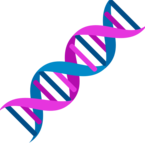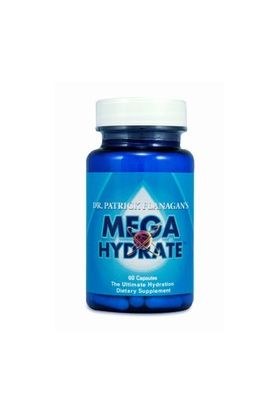MegaHydrate is the key that unlocks the potential of water as the medium for nutrient replenishment and waste removal at the cellular level. In a state of dehydration, body cells cannot assimilate nutrients and remove waste and relief pain from conditions like arthritis or fibromyalgia. Dehydration also occurs as a side effect of caffeine. Caffeine effects include anxiety, dizziness, headaches, sleep disorders, and many common ailments. MegaHydrate also helps fight the negative effects of alcohol, stress, and free radicals as part of aging. In addition to hydration, MegaHydrate is the most powerful known antioxidant food. Since it is an "pure" antioxidant that does not turn into a free radical itself, taken daily, MegaHydrate delivers far more Hydrogen ions than by eating pounds of raw fruits and vegetables or drinking gallons of "healing waters," also known as "glacial milk." Humans need Hydrogen to survive. It is the key to long life and anti-aging. However, due to mass food production, mineral deficient soil, pesticides, chemical fertilizers, over-processing of foods, chemical preservatives, and drinking over-chlorinated and over-fluoridated water, people do not get enough Hydrogen ions daily. Body cells become damaged, hydration levels decrease and cells age. In summary, MegaHydrate challenges the symptoms of dehydration and minimizes the process of aging. Many customers report immediate pain relief and increases in energy. MegaHydrate is a dietary supplement that is considered a food grade supplement rich in antioxidants by the FDA. Antioxidant foods like MegaHydrate help defy the aging process. It is safe, having been tested and shown to have no known side effects. Find out why MegaHydrate is more powerful than other antioxidant food and how it can help you. Megahydrate heps the body produce NADH
NADH-“THE” Performance Enhancing Supplement?
Posted by Gunnar Ljunggren on June 24, 2011
One of the key components in both Cabergolean and ERGO-BLITZ is NADH or beta-nicotinamide adeninedinucleotide. NADH is a coenzyme, which simply means it helps other enzymes carry out certain biological functions. It is considered by many researchers and scientists to be the most important coenzyme in humans and one of the most critical molecules in the human body.
Here are just some of the conditions that clinicians might utilize NADH to treat:
· Chronic fatigue syndrome
· Fibromyalgia
· Parkinson’s disease
· Alzheimer’s disease
· Depression
· Jet lag
· Attention Deficit Hyperactivity Disorder (ADHD)
NADH was discovered roughly 100 years ago; however, it has not been until this century that we have fully come to understand NADH's impact at the cellular level. Although there are numerous ways that NADH supplementation can improve function in humans- we will primarily highlight its effects on cognitive ability and athletic performance.
NADH and Cognitive Ability (Athletic “Smarts”)
It is this bloggers opinion that cognitive function and athletic performance’s relationship is extremely underestimated. Often times you hear about the best athletes in the world having “smarts”. Football smarts or basketball smarts- etc. The ability of a Brian Urlacher to be able to scan an offensive formation at pre-snap and make a change for his defense is paramount to the teams success on the field- and the difference between a “good” defense and a “great” defense. The ability for a Brian Urlacher to be able to key in on the movement of linemen and backs on the offensive side of the ball and make a split second educated guess as to where the play is headed is the difference between a “good” linebacker and a “great” one. Troy Polamalu is heralded as one of the best defenders in the game. It is not his athletic ability that usually inspires this accolade (although he is a great athelete!)- it is his cognitive function that separates him from the rest of the NFL safeties. He has football “smarts”.
One third of all the energy we produce in our body is used up by our brain. An energy deficiency is first realized in the brain with symptoms such as lack of concentration and alertness, or mental fog.
How does NADH provide the brain with more energy you ask?
The energy within our bodies is produced when hydrogen and oxygen react to form water and energy. NADH is the biological form of hydrogen present in our cells and oxygen comes from the air we breathe. The energy produced from this reaction is stored as a chemical compound, ATP (adenosine triphosphate).
You would certainly agree that if you had a deficiency in oxygen that oxygen supplementation would be mission critical right!? Well NADH is the other side of that equation: No oxygen- no ATP. No hydrogen- no ATP. No ATP- no energy. Pretty simple right!
NADH also affects general cognitive function by stimulating the production of adrenaline and dopamine, both of which are essential for our cognitive performance and memory. NADH has been clinically proven to improve cognitive function in sleep deprived adults (Virre, 48th International Congress of Aviation and Space Medicine, 2000). And unlike waking up to a big cup of coffee and then feeling like Monday morning’s garbage before noon again- NADH carries out its effects on cognitive function in a much different capacity than caffeine or other stimulants do.
Caffeine and the other stimulants release adrenaline (also called epinephrine) from the nerve cells. This triggers a quick boost in adrenaline. You are less tired and more alert; however, only for a very short time. The next cup of coffee will not give you the same boost as the first one because your adrenaline pool in the nerve cells has been emptied. If the pool of adrenaline in your central nervous system is totally depleted, you can drink as much coffee as you want but you will not get any more boost.
NADH on the other hand stimulates the biosynthesis of adrenaline, and due to this, fills the pool of adrenaline in the central nervous system. This is the essential prerequisite for caffeine to become active.
In addition, NADH increases the real ATP energy in the cells. With more energy the nerve cells produce not only more adrenaline and dopamine but also serotonin and other components necessary for good performance. NADH is the only substance which has been shown to increase cellular energy. Coffee and “energy supplements” do not increase cellular energy, in fact they do nothing but release adrenaline from nerve cells and are therefore mere stimulants.
NADH and Athletic Performance
Researchers are just beginning to look at NADH's possible applications for athletic performance. Theoretically, physiologic functions boosted by NADH could have beneficial effects for athletes. Research conducted by Birkmayer and colleagues (Birkmayer, International Journal of Sports Medicine 1996) on competitive athletes does indicate that NADH enhances work capacity. Researchers measured reaction times, physical performance and performance quality in 17 competitive cyclists and long-distance runners. Physical performance was measured on a bicycle ergometer. Performance quality was determined by measurements of continuous attention.
Athletes underwent these tests both before and after taking 5 mg of NADH before breakfast each morning for four weeks. During the test period, subjects kept constant the frequency and intensity of their training and exercise program as well as lifestyle factors. After four weeks of NADH supplementation, most athletes experienced significantly less scattering of reaction times-it dropped by 10 percent in five athletes, 10 to 20 percent in eight athletes, and more than 20 percent in three athletes. Reaction time overall improved considerably in 16 out of the 17 subjects.
Compared to baseline measurements, parameters for physical performance also improved. For two athletes, the maximum work performance (work at max per kg/body weight) increased by more than 10 percent, with another seven showing increases of up to 10 percent. Similar improvements were made in maximum oxygen uptake (VO2max/kg).
Researchers hypothesized that improved reaction times may have resulted from prior NADH deficiency in some athletes or an increase in dopamine production that led to increased alertness and vigilance. The latter explanation is further supported by studies wherein NADH supplementation increased dopamine production in rats. The researchers went on to say that stimulation of cellular ATP production by NADH may have enhanced, athletic performance- more NADH a cell has available, the more energy it can produce. Conversely, an NADH deficiency results in reduced strength, power and performance. The report concluded, "From the changes observed after taking NADH for four weeks, it seems justified to perform a double-blind, placebo-controlled study with a larger number of athletes."
In addition to improving athletic performance via ATP production NAHD has also been shown to increase L-Dopa production and Nitric Oxide production.
Well (as an athlete) why do we care if NADH increases L-Dopa production?
Numerous reasons- but in this conversation it is specifically utilized to stimulate Growth Hormone release from the pituitary gland.
NADH triggers the activation of tyrosine-hydroxylase. Tyrosine hydroxylase or tyrosine 3-monooxygenase is the enzyme responsible for catalyzing the conversion of the amino acid L-Tyrosine (an ingredient in Cabergolean) to L-Dopa. L-Dopa has been shown in numerous studies to be an effective compound for the stimulation of GH release by the pituitary gland. Growth Hormone has been shown in numerous studies to (among other functions) stimulate IGF production, which in turn creates new muscle cells through differentiation and proliferation. This white paper is not a treatise on the benefits of GH; however, there are scores of studies that illuminate its positive effect on athletic performance.
NADH also Increases Nitric Oxide (NO) bioavailability. As a matter of fact Dr. Tadeusz Malinski (the first man to discover how to measure the cellular output of nitric oxide) states that NADH stimulates NO production 10 x more than any substance he has ever tested! As an aside, if you are taking a “NO Supplement” and it does not include NADH, you are throwing away your money!!!
But I digress. So how does NADH increase the bioavailabilty of Nitric Oxide?
The Coenzyme of the enzyme NO-Synthase is NAHD. The more NADH available, the more NO can be produced. NO mediates vasodilation (an expansion of the internal diameter of blood vessels), which in turn leads to increased blood flow, oxygen transport, delivery of nutrients to skeletal muscle and a reduction in blood pressure.
Athletes know that Nitric Oxide is a valuable part of their success because it’s responsible for blood flow, oxygen delivery, glucose uptake, muscle velocity, power output, and muscle growth.
Increasing Nitric Oxide levels can deliver continuous muscle benefits such as:
· Faster gains in lean mass
· Greater strength
· Providing better muscle recovery
· Increasing endurance


